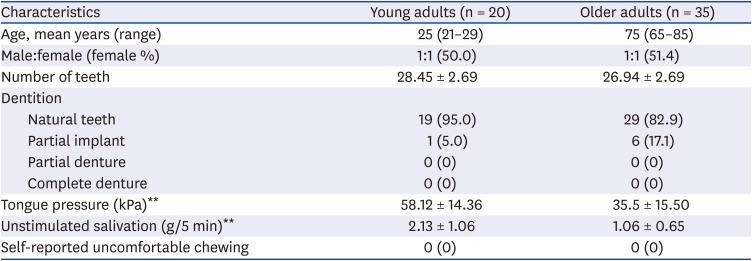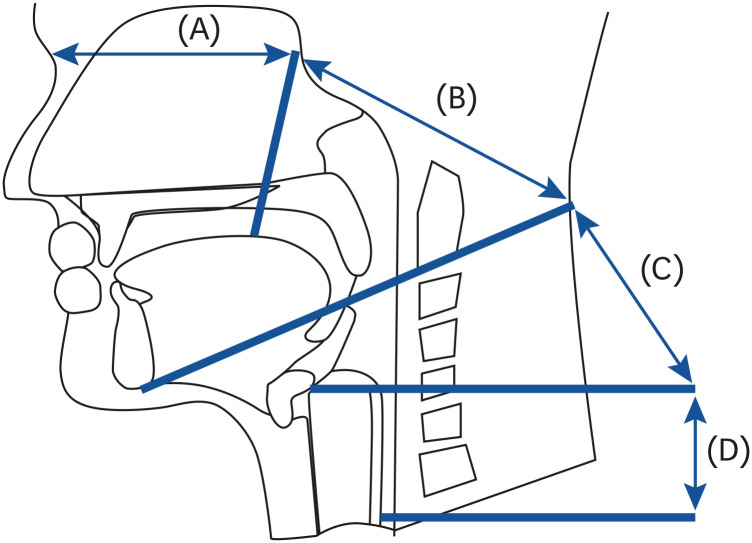1. Mioche L, Bourdiol P, Peyron MA. Influence of age on mastication: effects on eating behaviour. Nutr Res Rev. 2004; 17:43–54. PMID:
19079914.
2. Matsuo K, Fujishima I. Textural changes by mastication and proper food texture for Patients with Oropharyngeal Dysphagia. Nutrients. 2020; 12:1613.
3. Wada S, Goto T, Fujimoto K, Watanabe M, Nagao K, Nakamichi A, Ichikawa T. Changes in food bolus texture during mastication. J Texture Stud. 2017; 48:171–177. PMID:
28370114.
4. Sura L, Madhavan A, Carnaby G, Crary MA. Dysphagia in the elderly: management and nutritional considerations. Clin Interv Aging. 2012; 7:287–298. PMID:
22956864.
5. Hildebrandt GH, Dominguez BL, Schork MA, Loesche WJ. Functional units, chewing, swallowing, and food avoidance among the elderly. J Prosthet Dent. 1997; 77:588–595. PMID:
9185051.
6. Park S, Shin WS. Differences in eating behaviors and masticatory performances by gender and obesity status. Physiol Behav. 2015; 138:69–74. PMID:
25447481.
7. Foster KD, Grigor JMV, Cheong JN, Yoo MJY, Bronlund JE, Morgenstern MP. The role of oral processing in dynamic sensory perception. J Food Sci. 2011; 76:R49–R61. PMID:
21535784.
8. Kang AJ, Kim DK, Kang SH, Seo KM, Park HS, Park KH. EMG Activity of masseter muscles in the elderly according to rheological properties of solid food. Ann Rehabil Med. 2016; 40:447–456. PMID:
27446781.
9. Park HS, Kim DK, Lee SY, Park KH. The effect of aging on mastication and swallowing parameters according to the hardness change of solid food. J Texture Stud. 2017; 48:362–369. PMID:
28967219.
10. Cichero JAY. Adjustment of food textural properties for elderly patients. J Texture Stud. 2016; 47:277–283.
13. The IDDSI Framework [Internet]. International Dysphagia Diet Standardization Initiative;2021. cited 2021 June. Available from:
http://iddsi.org/Framework.
14. Park S, Kim JS, Jung EK. Institutional foodservice personnel's perception and use of care foods for elderly individuals' chewing and swallowing ability. J Korean Soc Food Sci Nutr. 2018; 47:186–194.
15. Iguchi H, Magara J, Nakamura Y, Tsujimura T, Ito K, Inoue M. Changes in jaw muscle activity and the physical properties of foods with different textures during chewing behaviors. Physiol Behav. 2015; 152:217–224. PMID:
26440319.
16. Rothenberg E, Ekman S, Bülow M, Möller K, Svantesson J, Wendin K. Texture-modified meat and carrot products for elderly people with dysphagia: preference in relation to health and oral status. Scand J Food Nutr. 2007; 51:141–147.
17. Lassauzay C, Peyron MA, Albuisson E, Dransfield E, Woda A. Variability of the masticatory process during chewing of elastic model foods. Eur J Oral Sci. 2000; 108:484–492. PMID:
11153923.
18. Jeltema M, Beckley J, Vahalik J. Model for understanding consumer textural food choice. Food Sci Nutr. 2015; 3:202–212. PMID:
25987995.
19. Slavicek G, Soykher M, Gruber H, Siegl P, Oxtoby MA. A novel standard food model to analyze the individual parameters of human mastication. Int J Stomatol Occlusion Med. 2009; 2:163–174.
20. Bourne MC. Principles of objective texture measurement. Bourne MC, editor. Food Texture and Viscosity: Concept and Measurement. San Diego, (CA): Academic Press;2002. p. 107–188.
21. Sabaneeff A, Caldas LD, Garcia MA, Nojima MC. Proposal of surface electromyography signal acquisition protocols for masseter and temporalis muscles. Res Biomed Eng. 2017; 33:324–330.
22. Chan HJ, Woods M, Stella D. Mandibular muscle morphology in children with different vertical facial patterns: a 3-dimensional computed tomography study. Am J Orthod Dentofacial Orthop. 2008; 133:10.e1–10.13.
23. Cecílio FA, Regalo SC, Palinkas M, Issa JP, Siéssere S, Hallak JE, Machado-de-Sousa JP, Semprini M. Ageing and surface EMG activity patterns of masticatory muscles. J Oral Rehabil. 2010; 37:248–255. PMID:
20158599.
24. Hiraoka T, Palmer JB, Brodsky MB, Yoda M, Inokuchi H, Tsubahara A. Food transit duration is associated with the number of stage II transport cycles when eating solid food. Arch Oral Biol. 2017; 81:186–191. PMID:
28551510.
26. Kwon SH, Park HR, Lee YM, Kwon SY, Kim OS, Kim HY, Lim YS. Difference in food and nutrient intakes in Korean elderly people according to chewing difficulty: using data from the Korea National Health and Nutrition Examination Survey 2013 (6th). Nutr Res Pract. 2017; 11:139–146. PMID:
28386387.
27. Bakke M, Holm B, Jensen BL, Michler L, Möller E. Unilateral, isometric bite force in 8–68-year-old women and men related to occlusal factors. Scand J Dent Res. 1990; 98:149–158. PMID:
2343274.
28. Newton JP, Yemm R, Abel RW, Menhinick S. Changes in human jaw muscles with age and dental state. Gerodontology. 1993; 10:16–22. PMID:
8300113.
29. Kohyama K, Mioche L, Martin JF. Chewing patterns of various texture foods studied by electromyography in young and elderly populations. J Texture Stud. 2002; 33:269–283.
30. Feldman RS, Kapur KK, Alman JE, Chauncey HH. Aging and mastication: changes in performance and in the swallowing threshold with natural dentition. J Am Geriatr Soc. 1980; 28:97–103. PMID:
7354209.
31. Mioche L, Bourdiol P, Monier S, Martin JF. The relationship between chewing activity and food bolus properties obtained from different meat textures. Food Qual Prefer. 2002; 13:583–588.
32. Schiffman SS. Taste and smell losses in normal aging and disease. JAMA. 1997; 278:1357–1362. PMID:
9343468.
33. Iida Y, Katsumata A, Fujishita M. Videofluorographic evaluation of mastication and swallowing of Japanese udon noodles and white rice. Dysphagia. 2011; 26:246–249. PMID:
20820808.
34. Hiiemae KM, Palmer JB. Food transport and bolus formation during complete feeding sequences on foods of different initial consistency. Dysphagia. 1999; 14:31–42. PMID:
9828272.
35. Kim DH, Hwang SJ. Influence of the food intake ability and the number of remaining teeth on oral health related quality of life in some elderly people. J Dent Hyg Sci. 2016; 16:53–61.
36. Carlos JP, Wolfe MD. Methodological and nutritional issues in assessing the oral health of aged subjects. Am J Clin Nutr. 1989; 50:1210–1218. PMID:
2683731.









 PDF
PDF Citation
Citation Print
Print




 XML Download
XML Download